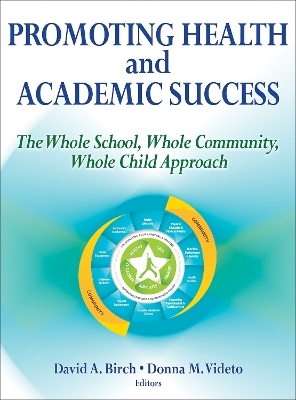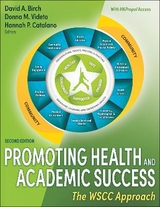
Promoting Health and Academic Success
Human Kinetics (Verlag)
978-1-4504-7765-9 (ISBN)
- Titel erscheint in neuer Auflage
- Artikel merken
There is increasing evidence that health and academic success go hand in hand. Now educators and health professionals have a new model—the Whole School, Whole Community, Whole Child (WSCC) approach—to use in promoting health and learning in the schools. This new approach, developed by leaders in education and health, is a transition from the coordinated school health (CSH) model that was introduced in 1987.
Promoting Health and Academic Success is a new resource for the transition from CSH to WSCC. Written by national leaders in education and school health, some of whom were involved in the development of WSCC, this book provides direction for education and school health professionals interested in promoting student health. It is valuable for individuals and groups interested in advocating for WSCC and for those engaged in the planning, implementation, and evaluation of this new approach.
The book also is a resource for both undergraduate and graduate students in courses that address a coordinated approach to school health. Each chapter includes application activities that engage students in translating their learning in the context of WSCC simulations. In addition, the School Health in Action feature provides case studies that demonstrate the impact school health programs are having in schools across the United States.
Applicable to both students and professionals, Promoting Health and Academic Success includes an appendix that presents a thorough guide to using school health assessment tools created by organizations such as the Centers for Disease Control and Prevention, Association for Supervision and Curriculum Development, and the National Association of State Boards of Education. Following is a partial listing of the tools:
• The School Health Index helps schools improve health and safety policies.
• The State Schools Health Policy Database facilitates sharing of policies across states.
• The Health Education Curriculum Analysis Tool encourages children to adopt and maintain health-enhancing behaviors.
• The Physical Education Curriculum Analysis Tool assists schools in analyzing their curricula and comparing it to national physical education standards.
• A Parent Engagement tool shares strategies for involving parents in school health.
The book is presented in five parts. Part I unveils the new WSCC model, explains its components, and provides a historical overview of coordinated school health. Part II offers insights into the Whole Child initiative and examines the evidence linking health and academic success. Part III explores the crucial role of school administration in ensuring success, ways to meet the diverse needs of students and their families, and methods for getting the community involved. Part IV delves into planning, implementation, and evaluation aspects of WSCC. Part V looks to the future for WSCC and provides perspectives from the field. The appendix supplies the assessment instruments and tools.
David A. Birch, PhD, MCHES, is professor and chair of the department of health science at the University of Alabama. He is president-elect of the Society for Public Health Education (SOPHE) and is past president of the American Association for Health Education (AAHE). He has served on the board of directors of AAHE, the American School Health Association (ASHA), and the National Association of Health Education Centers (NAHEC) and on the board of trustees of the Society for Public Health Education (SOPHE). Dr. Birch is cochair of the National Implementation Task Force for Accreditation in Health Education, a member of the Governing Council of the American Public Health Association, and a member of the board of directors of the Foundation for the Advancement for Health Education. He is chair of the editorial board of the Journal of School Health and a member of the editorial boards of Pedagogy in Health Promotion: The Scholarship of Teaching and Learning and the American Journal of Health Studies. Dr. Birch is a charter fellow of AAHE and a fellow of ASHA. He has received the Eta Sigma Gamma Honor Award (2015), the SOPHE Presidential Citation (2012), the ASHA Outstanding Researcher Award (2010), AAHE Professional Service Award (2008), the AAHE Presidential Citation (2008, 2012, and 2013), and the ASHA Distinguished Service Award (1996). He was the 2008 Ann E. Nolte Scholar in Health Education at Illinois State University and a 2000 Robert D. Russell Scholar at Southern Illinois University at Carbondale. As a faculty member at Indiana University, Dr. Birch received the Trustee’s Teaching Award and the Teaching Excellence Recognition Award. His research interests include professional preparation, professional leadership, and the Whole School, Whole Community, Whole Child model. Donna M. Videto, PhD, MCHES, is a professor of health at SUNY College at Cortland. She is a national leader in school health and has published articles on health education in several journals, written chapters in four books, and coauthored a book on assessment in health education. She has also made numerous presentations across the United States on health education and was given the 2012 New York AHPERD Amazing People Award for outstanding contributions and commitment to professional excellence. She became an American Association for Health Education fellow in 2012, and she has received several awards for her teaching. Videto is a member of the American School Health Association and the Society for Public Health Education.
Part I: Moving From Coordinated School Health to the Whole School, Whole Community, Whole Child Approach
Chapter 1 Whole School, Whole Community, Whole Child: A New Model for Health and Academic Success
David A. Birch and Donna M. Videto
Evolution of School Health Models
Creation of WSCC
Summary
Learning Aids
Chapter 2 Historical Overview of Coordinated School Health
Diane DeMuth Allensworth
First Stage of Health Promotion: Addressing Infectious Diseases
Second Stage of Health Promotion: Addressing Individual Behaviors
Third Stage of Health Promotion: Addressing the Social Determinants of Health
Barriers to Universal Adoption of CSH
Next Evolution for School Health
Summary
Learning Aids
Chapter 3 Components of the WSCC Model
David A. Birch, Qshequilla Mitchell, and Hannah M. Priest
Health Education
Parent and Family Engagement
Physical Environment
Social and Emotional Climate
Physical Education and Physical Activity
Counseling, Psychological, and Social Services
Health Services
Nutrition Environment and Services
Employee Wellness
Summary
Learning Aids
Part II: Putting the Focus on the Child
Chapter 4 The Whole Child Initiative
Sean Slade
Whole Child Tenets
Links Between Health and Education
“Healthy” as a Key Tenet of the Whole Child Initiative
Gaining Support for the Whole Child Initiative
Nine Levers for Cultural Change
Sustainability
Relevance for Whole School, Whole Community, Whole Child
Summary
Learning Aids
Chapter 5 Linking Health and Academic Success
Michele Wallen
Health and Education in Early Childhood
Health-Risk Behaviors and Academic Achievement
Making a Difference Through the WSCC Approach
Summary
Learning Aids
Part III: Building Partnerships and Support
Chapter 6 Role of School Administration
Jeremy Lyon
Need for School Health Promotion
School Administrators as Advocates for WSCC
Embracing the Leadership Role in WSCC
Promoting Change
Schools as Centers for Employee Wellness
Identifying Health Champions
Identifying a Leader
Moving Forward
Summary
Learning Aids
Chapter 7 Meeting the Needs of Diverse Students, Families, and Communities
Angelia M. Paschal
Diverse Students and School Connectedness
Diverse Family Involvement
Diverse Community Engagement
Cultural Competence Strategies
Whole School, Whole Community, Whole Child Approach
Summary
Learning Aids
Chapter 8 Community Involvement
Bonni C. Hodges and Lisa Angermeier
Need for School–Community Collaborations
Stages of Collaboration
Barriers to Collaboration
Characteristics of Effective School–Community Collaborations
Summary
Learning Aids
Part IV: Planning, Implementation, and Evaluation
Chapter 9 Planning for WSCC
Bonni C. Hodges and Donna M. Videto
Need for Systematic Planning
Creating a Comprehensive Profile
Actions for Collecting Profile Data
Implications for WSCC
Summary
Learning Aids
Chapter 10 Implementing WSCC
Donna M. Videto and David A. Birch
1. Secure and Maintain Administrative Support and Commitment
2. Establish a District Health Council and School Teams
3. Identify a School Health Coordinator
4. Set Goals and Objectives and Then Develop a Plan
5. Implement the Plan and Strategies
ASCD and CDC Combined Strategies 5, 6, and 7
Summary
Learning Aids
Chapter 11 Evaluating WSCC
Robert Valois
Rationale for Program Evaluation
Planning for Program Evaluation
Developing an Evaluation Plan: CDC’s Framework for Program Evaluation
Internal or External Program Evaluation
Types of Evaluation
Quantitative and Qualitative Data Collection
Summary
Learning Aids
Part V: The Path Forward
Chapter 12 Building on the Past and Moving Into the Future
Sean Slade
CSH Success
Focus on Standardized Testing
Beyond Cooperation: Alignment and Integration
Healthy Learning Environment
Responding to Trends in Education
ASCD and CDC
What’s in It for Education?
What’s in It for Health?
Summary
Chapter 13 Perspectives From the Field
Sharon Murray
Karen Cottrell
Richard A. Lyons
Barb McDowell
Vanessa Booth
Rochelle Davis
Beth H. Chaney
Linda Morse
Denise M. Seabert
Deborah A. Fortune
Jill Deuink Pace
Laurence Spring
Caroline Eberle
Sharon Murray
| Verlagsort | Champaign, IL |
|---|---|
| Sprache | englisch |
| Maße | 216 x 279 mm |
| Gewicht | 680 g |
| Themenwelt | Sachbuch/Ratgeber ► Gesundheit / Leben / Psychologie |
| Schulbuch / Wörterbuch ► Lexikon / Chroniken | |
| Sozialwissenschaften ► Pädagogik ► Didaktik | |
| ISBN-10 | 1-4504-7765-8 / 1450477658 |
| ISBN-13 | 978-1-4504-7765-9 / 9781450477659 |
| Zustand | Neuware |
| Haben Sie eine Frage zum Produkt? |
aus dem Bereich



